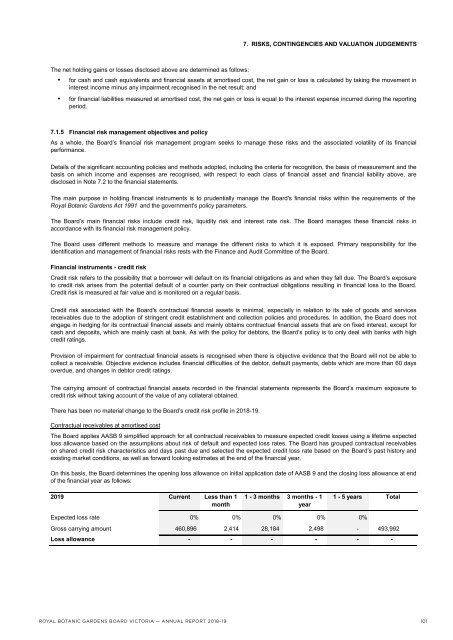Royal Botanic Gardens Victoria Annual Report 2018-19
Royal Botanic Gardens Victoria Annual Report 2018-19
Royal Botanic Gardens Victoria Annual Report 2018-19
Create successful ePaper yourself
Turn your PDF publications into a flip-book with our unique Google optimized e-Paper software.
7. RISKS, CONTINGENCIES AND VALUATION JUDGEMENTS<br />
The net holding gains or losses disclosed above are determined as follows:<br />
h<br />
h<br />
for cash and cash equivalents and financial assets at amortised cost, the net gain or loss is calculated by taking the movement in<br />
interest income minus any impairment recognised in the net result; and<br />
for financial liabilities measured at amortised cost, the net gain or loss is equal to the interest expense incurred during the reporting<br />
period.<br />
7.1.5<br />
Financial risk management objectives and policy<br />
As a whole, the Board’s financial risk management program seeks to manage these risks and the associated volatility of its financial<br />
performance.<br />
Details of the significant accounting policies and methods adopted, including the criteria for recognition, the basis of measurement and the<br />
basis on which income and expenses are recognised, with respect to each class of financial asset and financial liability above, are<br />
disclosed in Note 7.2 to the financial statements.<br />
The main purpose in holding financial instruments is to prudentially manage the Board's financial risks within the requirements of the<br />
<strong>Royal</strong> <strong>Botanic</strong> <strong>Gardens</strong> Act <strong>19</strong>91 and the government's policy parameters.<br />
The Board’s main financial risks include credit risk, liquidity risk and interest rate risk. The Board manages these financial risks in<br />
accordance with its financial risk management policy.<br />
The Board uses different methods to measure and manage the different risks to which it is exposed. Primary responsibility for the<br />
identification and management of financial risks rests with the Finance and Audit Committee of the Board.<br />
Financial instruments - credit risk<br />
Credit risk refers to the possibility that a borrower will default on its financial obligations as and when they fall due. The Board’s exposure<br />
to credit risk arises from the potential default of a counter party on their contractual obligations resulting in financial loss to the Board.<br />
Credit risk is measured at fair value and is monitored on a regular basis.<br />
Credit risk associated with the Board's contractual financial assets is minimal, especially in relation to its sale of goods and services<br />
receivables due to the adoption of stringent credit establishment and collection policies and procedures. In addition, the Board does not<br />
engage in hedging for its contractual financial assets and mainly obtains contractual financial assets that are on fixed interest, except for<br />
cash and deposits, which are mainly cash at bank. As with the policy for debtors, the Board’s policy is to only deal with banks with high<br />
credit ratings.<br />
Provision of impairment for contractual financial assets is recognised when there is objective evidence that the Board will not be able to<br />
collect a receivable. Objective evidence includes financial difficulties of the debtor, default payments, debts which are more than 60 days<br />
overdue, and changes in debtor credit ratings.<br />
The carrying amount of contractual financial assets recorded in the financial statements represents the Board’s maximum exposure to<br />
credit risk without taking account of the value of any collateral obtained.<br />
There has been no material change to the Board’s credit risk profile in <strong>2018</strong>-<strong>19</strong>.<br />
Contractual receivables at amortised cost<br />
The Board applies AASB 9 simplified approach for all contractual receivables to measure expected credit losses using a lifetime expected<br />
loss allowance based on the assumptions about risk of default and expected loss rates. The Board has grouped contractual receivables<br />
on shared credit risk characteristics and days past due and selected the expected credit loss rate based on the Board’s past history and<br />
existing market conditions, as well as forward looking estimates at the end of the financial year.<br />
On this basis, the Board determines the opening loss allowance on initial application date of AASB 9 and the closing loss allowance at end<br />
of the financial year as follows:<br />
20<strong>19</strong> Current Less than 1<br />
month<br />
1 - 3 months 3 months - 1<br />
year<br />
1 - 5 years<br />
Total<br />
Expected loss rate<br />
Gross carrying amount<br />
Loss allowance<br />
0% 0% 0% 0% 0%<br />
460,896 2,414 28,184 2,498 - 493,992<br />
- - - - - -<br />
ROYAL BOTANIC GARDENS BOARD VICTORIA — ANNUAL REPORT <strong>2018</strong>–<strong>19</strong> 101<br />
<strong>Royal</strong> <strong>Botanic</strong> <strong>Gardens</strong> Board <strong>Victoria</strong> <strong>2018</strong>-<strong>19</strong> Financial <strong>Report</strong> Page 24


